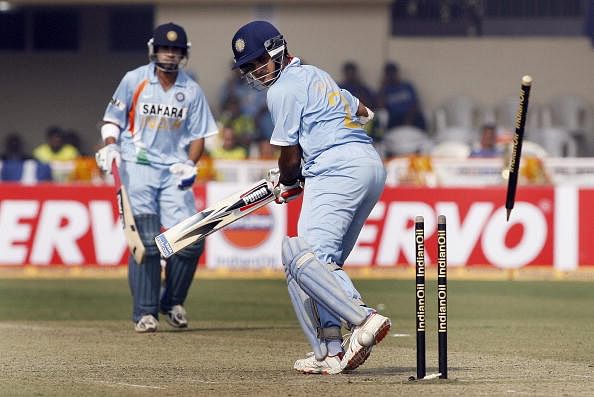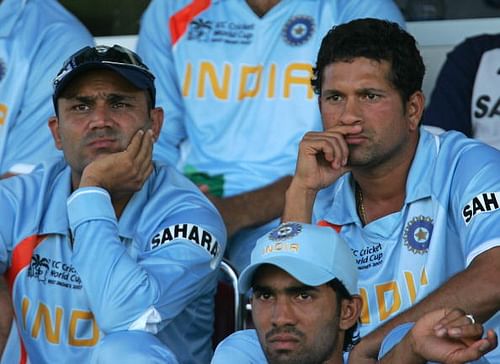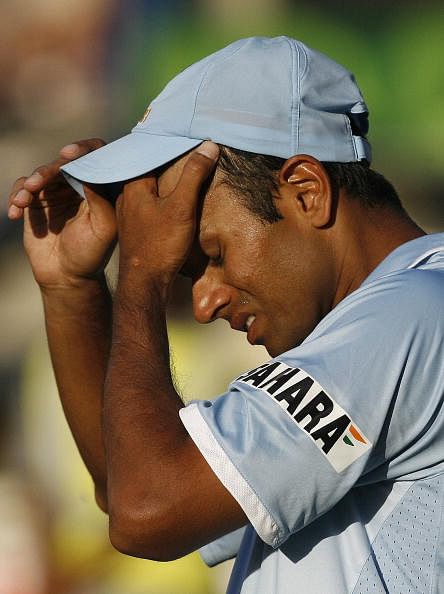
Memory Lanes: That World Cup Debacle

Australian Tour – the start of the downfall of Saurav Ganguly’s batting form. With the wins on Australian soil against Pakistan in 2004 and a successful 2003 World Cup on his CV, Ganguly was deemed the best captain India ever had by cricket pundits. But the runs from the southpaw’s willow dried up completely in 2004 and thereupon every single loss highlighted his dismal batting run even more. Don’t dismiss it as small event; it was much more than just a drop in a single player’s confidence; it was the drop in the confidence of a team whose captain had become diffident. As always, when things go wrong, ‘CHANGE’ is the buzzword.
One Fab-4 member’s decline meant a passing on of the baton. Rahul Dravid took over the leadership crown and as always, committed himself to a new role for the team. In an era of mixed wins and losses and enshrouding controversies, Dravid helped the team to some memorable wins in West Indies. Under Dravid-Chappell, the ‘report card’ was an impressive read. India jumped from the 7th ICC spot in ODIs to 3rd in quick time. The ODI squad saw Raina and Dhoni emerging as responsible young batters who could chase down targets easily. Yuvraj Singh’s career grew in stature. Notably, chasing targets was a rarity in Ganguly’s golden era. But as the World Cup drew near, doubts started to creep in. The young team had a disastrous Champions Trophy in 2006. It resulted in a comeback call for Saurav Ganguly to the frail ODI side. He justified selection with some good knocks that, though lacked the old touch, still went down as ‘runs’ on scoreboard. Some anchoring fifties against Sri Lanka and West Indies in Feb 2007 secured Ganguly a spot in the World Cup. Ganguly’s success and youngsters’ simultaneous dip had messed up the Chappell vision. The team that went to Caribbean was finally a veteran team that featured Sachin, Ganguly, Dravid and Kumble. All the legends of last decade. But no Laxman.
In September 2005, Greg Chappell took over the coaching reigns and pressed for the urgent need of blooding youngsters in team with the 2007 World Cup in sight. The scapegoats were the non-performing old legs. Chappell had emailed the Board of Control for Cricket in India, stating that Ganguly was “physically and mentally” unfit to lead India. This email was leaked to the media and resulted in huge recoil from Ganguly’s fans. And within a month, a groggy, out-of-form Saurav Ganguly was dropped and out-of-favour. A spate of controversies ensued, with the coach making the news for all the wrong reasons.
In an illustrious career that had seen some classy knocks, Laxman failed to make it to another World Cup. His own ODI form had dropped after a spate of ODI centuries in 2004 that looked like a second life to his ODI career. But more than the decline, it was inconsistency and ‘one-paced game’ as per Chappell that had kept him out-of-favour. The focus on fielding in that period always singled out Laxman. All this was despite his superb form in Australia and Pakistan in early 2004, when he made four centuries in 14 games, including three in a week in the VB Series in Australia. His good close-catching skills weren’t enough and a spate of centuries sandwiched between some inconsistent series kept him out of ODI side mostly. He showcased timely brilliance to silence critics, like in West Indies. But that was not enough for the five wise men and Chappell. As a final nail in the coffin, his dream of featuring in a World Cup seemed over when the World Cup team couldn’t afford him, with the age too nearing 33.

Sachin Tendulkar meanwhile was a shadow of its former self. His form was fickle, and his knocks had ‘accumulated singles’ written all over them. The injuries had cut down his shots, especially the hook shot he churned out in the 90s. Critics had written him off. Ricky Ponting and Jacques Kallis were at the peak of their careers, and Sachin’s records seemed vulnerable at one point of time. The World Cup affair of the little master raised hopes from fans, who wished to see him back among runs. And more than runs, back with that midas touch of old.
The World Cup was a dream that had eluded India for 20 years. A dream India’s Fabulous Four had not realized. India had fallen one short in 2003. It seemed a last shot at glory. Time was running out. Kumble was on the brink of retirement. All the hype of Chappell always had the keyword of World Cup mentioned in it. Time had come now. They were one of the favourites on slow Caribbean pitches with an experienced squad that looked formidable on paper. But they had to deliver on field, which unfortunately they didn’t.
In the opening match at Port-of-Spain, Bangladesh turned out to be the David who killed the Goliath. All of a sudden, the same formidable eleven looked brittle, the bowling attack became toothless, the batting crumbled. India didn’t lose the match; it lost the belief of winning the World Cup. The formalities of exit were completed in the first round itself. 2007 World Cup was perhaps the most controversial and dragging World Cup, with a stretched schedule, early exit of Asian giants India and Pakistan, the sudden death of Bob Woolmer and the last three overs of the final being played in darkness, inter alia. Add to that some retirements, like every edition of this marquee event has. And finally an expected Australian hat-trick of World Cups to wind off a World Cup, which most Indians had stopped watching after India’s exit.. The sole consolation for India was a one-sided game against Bermuda where Sehwag and Yuvraj showed signs of form. Tendulkar failed for the first time in a World Cup, the event where his run-making was almost customary till now. He looked out of sorts and out of runs, so did the team.
The image of a teary-eyed Dravid in the final moments of the loss to Sri Lanka had said it all. Dravid, a thinking captain, had done so much in the past two years of rebuilding with Chappell. All those series wins, all those home ground chases, all those strategies, all those controversies, all that hard work had evaporated with the bottom line of India’s early exit. Unexpected debacle would be perhaps the only thing linked when Dravid would be talked of as Indian Captain. It was clear that effigies will be burnt in protest. Some heads will roll. Some scapegoats will be singled out. Some inciting stories will be published in media. One thing was more certain: Inside that teary eye of Dravid, a dream of a nation had shattered.

The debacle meant a leeway for critics. The voices that were murmuring till now about Sachin’s retirement found strength. Rahul Dravid’s captaincy career seemed over. Saurav Ganguly did no good by scoring a selfish-looking fifty against Bangladesh. Indian cricket perhaps needed a renewal. A long-term vision was said to be lacking. Fresh legs were in demand again. The names of Yuvraj Singh cropped up for captaincy in some circles. All of a sudden, the fabulous four looked toothless in impact.
Like a kid who does everything right in practice but still gets nervous on the stage, India veterans had not come good at the biggest stage – THE WORLD CUP. In a cricketing nation with a short term memory, their past performances didn’t matter to the public anymore. The crevices had turned into gaping holes. They were being seen as heroes merely on paper; sheer nominal legends. Indian Cricket had found itself caught between the idea of youth and experience. The balance had perhaps gone awry. The strategies had gone awry perhaps. And perhaps, the career of the four Indian legends had too gone awry. But like all stories of superheroes, this end looked inapt and uncalled for. Heroes are always meant to end with a win, I learned in childhood. This could not have been the end…